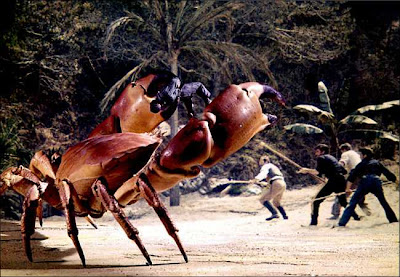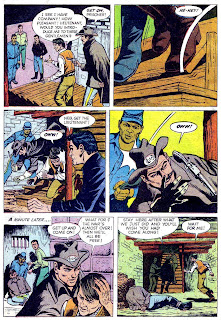 DC Comics's New Teen Titans Omnibus series has been controversial almost from the get-go. Aside from concerns over the binding, there was the strange omission of New Teen Titans issue #38 from Volume 2; DC originally solicited Volume 3 with a content listing that couldn't be right (too few and duplicate issues), and then they cancelled the third volume altogether and resolicited it a few months later.
DC Comics's New Teen Titans Omnibus series has been controversial almost from the get-go. Aside from concerns over the binding, there was the strange omission of New Teen Titans issue #38 from Volume 2; DC originally solicited Volume 3 with a content listing that couldn't be right (too few and duplicate issues), and then they cancelled the third volume altogether and resolicited it a few months later.Well, DC has finally released the New Teen Titans Omnibus Vol. 3, and with a hat-tip to Facebook friend and frequent commenter Xavico, it looks like the trouble's not over yet.
DC solicitations, and even their current web page, said the New Teen Titans Omnibus Vol. 3 would collect Tales of the Teen Titans #45-61 and 66-67, New Teen Titans #38, New Teen Titans #1-6, and Secret Origins Annual #3. We knew right away this wasn't right, because among other reasons, Tales #60-61 are actually the same comic as Titans #1-2, and even if what was just included were pin-ups or such, the contents were far too few to make an omnibus.
I've now learned that the contents of the Vol. 3 Omnibus are New Teen Titans #38, Tales of the New Teen Titans #45-50, New Teen Titans (Vol. 2) #1-6, New Titans #50-61, New Titans #66-67, and Secret Origin Annual #3.
In comparison, this means the omnibus collects not Tales of the Teen Titans #45-61 and 66-67, but rather Tales of the Teen Titans #45-50 and New Titans #66-67; added are New Titans #50-61.
Now, even as we might prefer the contents be listed right in the solicitations (and again, they're still wrong at the moment on DC's website), gaining ten or so extra issues isn't a bad thing. Unfortunately, however, there's some significant gaps in this volume that make for a tricky reading experience.
Titans Hunt for Missing Issues
That New Teen Titans #38, the first "Who is Donna Troy?" story, is here and not in the previous book seems silly to me since the first two volumes unfolded chronologically otherwise, but it appears here with the "Who is Wonder Girl?" story, so it's understandable. Tales #45 picks up where the last volume finished and continues to issue #50, Donna Troy's wedding. Still OK so far.Starting again with New Titans #1, however, jumps over Tales #51-58, and here we get a sense of what's really going on. Though billed as the New Teen Titans Omnibus series, these books are really the Marv Wolfman/George Perez Teen Titans Omnibus series. Tales #51-58 didn't have Perez on art; New Titans #1-6 did.
Then the book jumps again, skipping over forty issues to pick up with New Titans #50 when, you guessed it, Perez returned to the art again. At this point the book has lost all semblance of being a Titans omnibus and has instead become George Perez spotlight book (it's not a Marv Wolfman spotlight book, since Wolfman is the writer on a number of the issues that are skipped). There's nothing wrong with a Perez spotlight book per se (it's probably overdue), but I sincerely doubt that's what readers thought they were getting when they started buying this series years ago.
And even worse, New Titans issues #60-61 are parts 2 and 4 of the Batman story "A Lonely Place of Dying"; the other parts, written by Wolfman but drawn by Jim Aparo, are omitted. At this point if I'd purchased this book, I'd be steamed -- I specifically avoid DC's artist spotlight books because they contain "parts" and don't tell a full story; it's OK if that's your thing, but again, I don't think that's what readers were expecting at the beginning of this series and it feels like a bit of bait and switch now.
Others smarter than me can speak to this -- and in no way do I fault Wolfman or Perez for any of this -- but I wonder if this has to do with royalties, if it's easier to just include one writer and artist in this book and only pay two sets of royalties than to also pay to Aparo and others, the reader's experience irrespective.
Looking at this omnibus one more way, there's thirteen issues here that have never been reprinted (Tales #45-49, Titans #6, #56-59, and #66-67, and Secret Origin Annual #3), versus ten issues that have been collected before. That's not great, but it's actually better comparatively than the second New Teen Titans Omnibus, which only included one or two issues not found elsewhere.
Fool Me Twice ...
Chances are, with all the jumps, that this is the last New Teen Titans Omnibus. DC's track record on these series is not great -- there was the cancellation of the Starman Omnibus paperbacks mid-series recently, a seeming switch from the Chronicles volumes over to omnibus format, and the mid-series cancellation of collection series like Justice League International a couple years ago. After New Teen Titans, I wouldn't blame a reader for being wary here on out of starting to read any high-priced collection series until they know exactly how it's going to end.Still planning to pick up the New Teen Titans Omnibus Volume 3? Cancelled your order? Sound off in the comments and let me know!


















































































